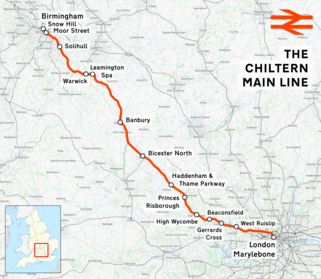| Chiltern Main Line | |||
|---|---|---|---|
 | |||
| Overview | |||
| Status | Operational | ||
| Owner | Network Rail | ||
| Locale | |||
| Termini | |||
| Stations | 32 | ||
| Service | |||
| Type | Commuter rail, Heavy rail | ||
| System | National Rail | ||
| Operator(s) |
| ||
| Rolling stock | |||
| History | |||
| Opened | 1910 (complete line) | ||
| Technical | |||
| Line length | 112 mi 4 chains (180 km) | ||
| Number of tracks | 2 | ||
| Track gauge | 4 ft 8+1⁄2 in (1,435 mm) standard gauge | ||
| Operating speed | 100 mph (160 km/h) maximum | ||
| |||
The Chiltern Main Line is a railway line which links London (Marylebone) and Birmingham (Moor Street and Snow Hill) on a 112-mile (180 km) route via High Wycombe, Bicester, Banbury, Leamington Spa and Solihull in England.
It is currently one of two main line railway routes between London and Birmingham; the other is the West Coast Main Line between London Euston and Birmingham New Street, which is the principal InterCity route between the two cities. A third main line, High Speed 2, is currently under construction.
The name Chiltern Line was invented as a marketing name for the line by Network SouthEast in 1985,[1] in reference to the Chiltern Hills which the route passes through near its southern end. The route was originally part of the Great Western Railway's main line from London Paddington to Birmingham Snow Hill, Wolverhampton Low Level and Birkenhead Woodside. Most main line services between London and Birmingham on this route were discontinued in 1967 after the West Coast Main Line was electrified, and Snow Hill station was closed.[2] Services were resumed between London and the reopened Snow Hill in 1993; however they were routed into Marylebone, formerly the London terminus of the now-closed Great Central Main Line, instead of the historic terminus at Paddington.[3]
Since the privatisation of British Rail in the 1990s, the main operator has been Chiltern Railways, who have continued to develop the route and services. In the early 2010s, the line underwent a major upgrade which saw much of the line cleared for 100 mph (160 km/h) running, resulting in significant reductions in journey times from 2013. The line is not electrified, although electrification is an aspiration.[4]
The line forms part of the suburban rail networks in both cities. The majority of towns towards the London end of the route are prosperous suburbs or commuter-belt towns, such as Ruislip, Gerrards Cross and Beaconsfield. These have a journey time of 30 minutes or less to London Marylebone. In the West Midlands it is one of the Snow Hill Lines. Commuter trains operated by West Midlands Trains run between Birmingham Snow Hill, Solihull and Leamington Spa, also to Stratford-upon-Avon.
- ^ "NSE CHRONOLOGY Jan 1982 to May 1986". Network SouthEast Railway Society. Archived from the original on 4 November 2013. Retrieved 22 April 2014.
- ^ "Birmingham Snow Hill Station - A brief overview". Warwickshire Railways. Retrieved 5 June 2016.
- ^ "The History of Network South East 1993". Network South East Railway Society. Archived from the original on 3 November 2013. Retrieved 5 June 2016.
- ^ Cite error: The named reference
shooterwas invoked but never defined (see the help page).
© MMXXIII Rich X Search. We shall prevail. All rights reserved. Rich X Search

